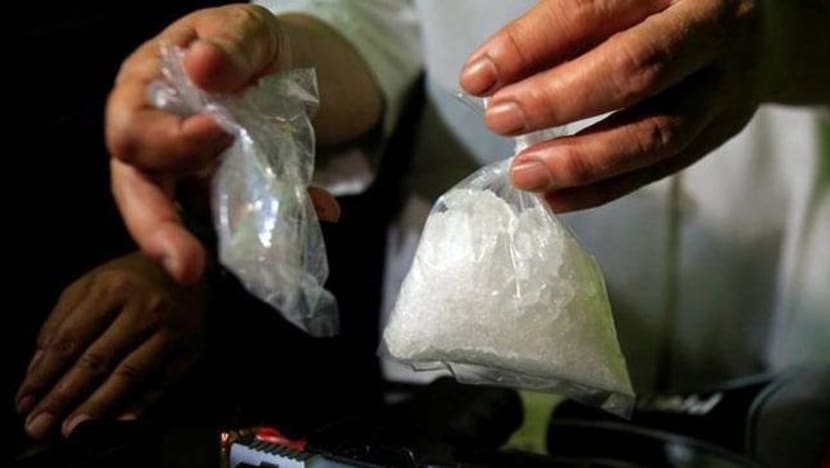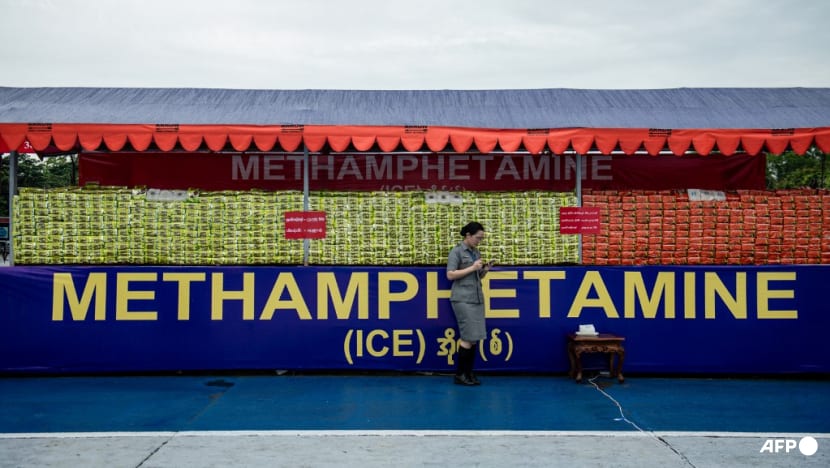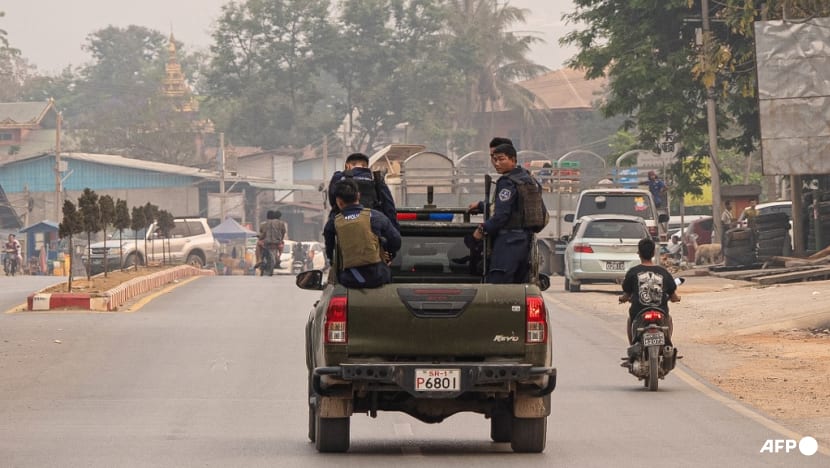Commentary: Myanmar’s war is powering a meth pipeline the region is struggling to stop
Synthetic drug production and trafficking in the region, particularly out of Myanmar’s Shan State, has grown exponentially in recent years, says former foreign correspondent Nirmal Ghosh.

File photo. Drug experts believe Myanmar may now be the world's biggest meth producer. (File photo: Reuters)

This audio is generated by an AI tool.
SINGAPORE: At first it was innocuous enough – a fishing boat far below, making its way across the azure blue surface of the Andaman Sea. But an Indian Coast Guard crew on a routine air patrol sensed something odd about it, and called it in.
A fast, armed Coast Guard cutter was dispatched from its base at Port Blair in the Andamans to intercept the boat. It quickly caught up and shadowed the vessel for some time. When the Myanmar-flagged boat crossed into Indian territorial waters, the Coast Guard moved in.
On board were six Myanmar nationals and a staggering 5.5 tonnes of crystal meth. It was the largest drug bust in India’s maritime history.
That haul on Nov 24, 2024, was both an indicator, and the proverbial drop in the ocean.
Synthetic drug production and trafficking in the region, particularly out of Myanmar’s Shan State, has grown exponentially in recent years. And it is fuelling a criminal economy Southeast Asia is finding hard to control.
CRIMINAL CONVERGENCE
Methamphetamine seizure in East and Southeast Asia hit a record 236 tonnes in 2024 – a 24 per cent increase over the previous year, according to a recent report from the United Nations Office on Drugs and Crime (UNODC).
At the heart of this problem is Shan State, Myanmar’s largest region by land. Bordering China, Laos and Thailand, it spans 155,800 sq km and is bigger than Nepal or Bangladesh.
It is part of the infamous Golden Triangle where Myanmar, Laos and Thailand meet among rice fields, dense jungles, mist-covered mountains, lazy rivers – and drugs, guns, and money.
“The volume of methamphetamine moving out of Shan State is likely larger than what is trafficked north out of Mexico, making Shan State the most geographically concentrated meth production centre in the world,” said Jeremy Douglas, UNODC’s chief of staff and strategy advisor, who has long focused on transnational crime in the Mekong region.
The capacity of the US to gather intelligence and secure borders is however far better than the neighbouring countries of the Golden Triangle and Southeast Asia, he told me.
While Myanmar has long grappled with illegal drugs, the problem has accelerated since a military coup in 2021 and the ensuing civil war, becoming what experts are saying is now a full-blown regional crisis that is, frighteningly, often beyond the capacity of local law enforcement.
Controlled by various ethnic armed groups – many of which are fighting Myanmar’s military and at times each other – Shan State is a patchwork of competing factions in a volatile region ravaged by poverty and conflict.
These groups, along with regime forces, have also converged with criminal organisations, leveraging and living off a range of illicit activity. These include meth production, illegal mining and logging, human trafficking, cyber scams and money laundering via underground banking and illegal online casinos.
What sets them apart from old-school drug cartels is how tech-savvy and decentralised they are. Encrypted messaging, drones, GPS trackers and cryptocurrency payments are part of their toolkit. They also use front companies as covers and operate cell-based networks that hire locals like drivers or fishermen to transport the drugs. Precursor chemicals needed to manufacture the drugs are often bought online using cryptocurrency and often shipped from suppliers in China and India.

A REGIONAL CRISIS
Of particular note is the role maritime routes play. The boat carrying the crystal meth seized by the Indian Coast Guard last November was intercepted 8 nautical miles from Barren Island, a volcanic island due east of India’s Andaman and Nicobar island chain, and roughly southwest of Yangon.
The crew on the boat had a satellite phone and was using Starlink to navigate. Intelligence sources believe the shipment originated in Tachilek in Shan State just across the Thai border from Mae Sai, and was shipped via Yangon, bound for several foreign markets including Australia and Japan – probably after being subdivided somewhere en route.
In July 2024, Indonesian authorities seized 106kg of crystal meth from a vessel off the Riau Islands. Three Indian nationals were arrested. Reports citing sources said the crystal meth was bound for Brisbane, Australia.
Meanwhile, it appears that Sabah, Malaysia, has also emerged as a new hub, with fishermen often recruited to ferry drugs across the Myanmar-Malaysia-Indonesia-Philippines route.
For instance, authorities confiscated 1,143kg of crystal meth in Sabah and Sarawak last year, nearly three times the amount the previous year.
The volume of crystal meth seized from boats is mirrored by higher volumes of drugs seized per shipment on land routes.
Thailand’s northern and northeastern borders with Myanmar and Laos respectively remain the busiest trafficking corridors. The porous route to India through that country’s northeast is also increasingly a problem for law enforcement.
In January this year, Thai forces in Chiang Rai province, for instance, seized over 1 tonne of crystal meth assessed as headed for markets in Japan, Australia and New Zealand.
And just last week (Jul 11), security forces in Zokhawthar, a town in India’s Mizoram state on the border with Myanmar, challenged two men with backpacks who then shed their packs and jumped into a river which they crossed into Myanmar. The packs revealed methamphetamine pills worth over US$13 million.
That was just one of almost daily seizures of thousands of methamphetamine tablets in northeast India, where rising local drug addiction has long been a worry. In parts of the region, like Manipur, the flow and use of drugs across the border feed into ethno-nationalist tensions entwined with mafia-like politics fuelling barely contained internal conflicts.
In terms of methamphetamine transit as well as use in Southeast Asia, Thailand remains an epicentre. Seizures of the drug, in both tablet and crystal form, continue to rise.
With little methamphetamine pills known as “yaba” retailing locally for only around 20 baht or less than US$1 each, stemming the tide is a daily battle for Thailand’s Office of the Narcotics Control Board (ONCB).
“It’s a nationwide epidemic,” said Ms Sritrakool Waeladee, director of the foreign affairs bureau of the ONCB, at a recent briefing at the Foreign Correspondents’ Club of Thailand.
In 2024, Thailand seized more than 900 tonnes of controlled precursor chemicals, while meth tablet seizures rose by over 55 per cent from 2023 to 2024.

THE CORE PROBLEM
The 10-member Association of Southeast Asian Nations (ASEAN) does recognise the threat. In October 2024, ASEAN leaders committed to strengthening cross-border cooperation and coordination against synthetic drugs. Experts have called for greater maritime cooperation between India, Thailand, Malaysia and Indonesia.
But much like the infamous Mexican drug cartels, the core of the problem, in Shan State, remains beyond the reach of individual countries in the region.
While there are several centres across the region manufacturing and pushing out synthetic drugs, the bottom line is that Shan State is the primary source.
However, further complicating a region rife with armed ethnic groups and criminal syndicates is an overlay of geopolitical competition. China, for example, is known to back, among others, the United Wa State Army and the Myanmar National Democratic Alliance Army.
The United States is largely sympathetic to the National Unity Government, which is a collection of groups fighting the military regime. India is worried about its volatile and misgoverned northeast being undermined by drugs and illicit money from Myanmar.
Only a negotiated peace between the warring factions, including Myanmar’s military regime, offers any hope of a solution to this Gordian knot. But that remains a distant prospect.
In its absence, the best one may hope for is that neighbouring countries in the interest of their own stability, beef up intelligence sharing, border security and enforcement.
Nirmal Ghosh, a former foreign correspondent, is an author and independent writer based in Singapore. He writes a monthly column for CNA, published every third Friday.


















